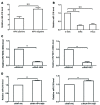miR‑218 functions as a tumor suppressor gene in cervical cancer
- PMID: 31746391
- PMCID: PMC6896272
- DOI: 10.3892/mmr.2019.10809
miR‑218 functions as a tumor suppressor gene in cervical cancer
Retraction in
-
[Retracted] miR‑218 functions as a tumor suppressor gene in cervical cancer.Mol Med Rep. 2024 Nov;30(5):202. doi: 10.3892/mmr.2024.13326. Epub 2024 Sep 20. Mol Med Rep. 2024. PMID: 39301660 Free PMC article.
Abstract
Previous microRNA (miR) microarray analysis revealed that miR‑218 is downregulated in cervical cancer tissues. The present study aimed to further evaluate the expression of miR‑218 in cervical cancer specimens, determine the association between its expression with disease progression, and investigate the roles of miR‑218 in cervical cancer cells. Tissue specimens were obtained from 80 patients with cervical squamous cell carcinoma, 30 patients with high‑grade cervical intraepithelial neoplasia [(CIN) II/III] and 15 patients with low‑grade CIN (CINI); in addition, 60 plasma samples were obtained from patients with cervical cancer, and 15 normal cervical tissue specimens and 30 plasma samples were obtained from healthy women. These samples were used for analysis of miR‑218 expression via reverse transcription‑-quantitative PCR. In addition, tumor cells were transfected with miR‑218 mimics, human papillomavirus (HPV)16 E6/E7 small interfering RNA, or their respective negative controls to determine the viability, colony formation, migration and invasion of cells using MTT, colony formation, wound healing and Transwell assays, respectively. Target genes of miR‑218 were bioinformatically predicted and analyzed using Gene Ontology (GO) terms. The results revealed that miR‑218 was downregulated in the tumor tissues and plasma of patients with cervical cancer, with expression associated with the advanced clinicopathological characteristics of patients, including HPV positivity, tumor size, blood vessel invasion and lymph node metastasis. Furthermore, miR‑218 overexpression reduced tumor cell viability and xenograft growth, and suppressed tumor cell migration and invasion. HPV was detected in 75% of the 80 patients with cervical cancer, and HPV positivity was inversely associated with miR‑218 expression. In addition, bioinformatics analysis predicted that roundabout guidance receptor 1 (ROBO1) was a target gene of miR‑218; miR‑218 overexpression significantly reduced ROBO1 levels. Furthermore, GO analysis revealed that ROBO1 was involved in regulating cell proliferation, adhesion and migration, and the cell cycle. In conclusion, the findings of the present study suggested that miR‑218 may possess antitumor activities in cervical cancer.
Keywords: cervical cancer; microrna; mir-218; biomarker.
Figures






References
-
- Gadducci A, Barsotti C, Cosio S, Domenici L, Riccardo Genazzani A. Smoking habit, immune suppression, oral contraceptive use, and hormone replacement therapy use and cervical carcinogenesis: A review of the literature. Gynecol Endocrinol. 2011;27:597–604. doi: 10.3109/09513590.2011.558953. - DOI - PubMed

